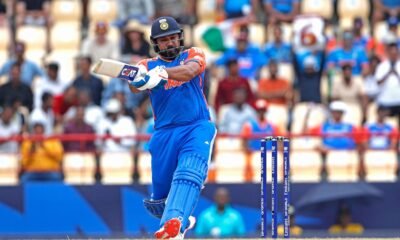Cricket
Australia and acing the game of tournament play | Cricket
[ad_1]
You’d have probably come across the phrase ‘peaking at the right time’ over the past few days with regards to Australia and the 2023 ODI World Cup. Here’s another term in the same context: tournament play.

“We seem to be peaking at the right time, which Australia tend to do in tournament play,” Mitchell Starc said in Kolkata before Australia beat South Africa to earn the right to play India in the final.
That’s a lot of sporting jargon in one sentence, but also one that the Aussies have stayed true to in this World Cup.
So, what exactly is tournament play? It has no definition, but reflects a trend — of starting slow in a marquee event that lasts a considerable length, picking up the pieces along with the pace just in time, switching gears and riding the gradually-built momentum deep. It’s a slow burner that shines the brightest when the stakes are highest.
The five-time ODI world champions began this World Cup with two timid defeats to India (6 wickets) and South Africa (134 runs), lying 10th in the points table at one point with no signs of an upswing. There were certainly none when Sri Lanka were 125 for no loss in Australia’s third league game. Until something flipped. David Warner took a spectacular outfield catch for the first Sri Lankan wicket, and off went Australia. On an eight-match winning run when another defeat or two could’ve well pulled them out of the knockouts race.
It still wasn’t (and isn’t) the Australia we know, yet it has turned into a team that knows how to eke out wins; even when things get too close for comfort (like against New Zealand, Afghanistan and in the semi-final). Like they did in the 1999 World Cup.
The building blocks of Pat Cummins’s troops — which ticked off various boxes as it motored along in India — stands in contrast with losing semi-finalists New Zealand and South Africa, who charged off the blocks before stumbling towards the business end. And even as Australia struggled to find any semblance of positivity in their early days, the belief that their best was yet to come in a long tournament kept their shoulders from dropping.
“It certainly wasn’t panic stations,” Starc told ABC Sport podcast before their penultimate league game against Afghanistan in Mumbai. “We were very aware we weren’t playing our best cricket. We’ve all played a lot of tournament play before — whether it be World Cups or BBLs (Big Bash League) or IPLs (Indian Premier League).”
Mumbai Indians perhaps best exemplify tournament play in the IPL. Perennial slow starters, they lost the opening four games of their triumphant 2015 season. A year prior, Kolkata Knight Riders lost five of their first seven games before hitting their best notes in the business end of the title-winning dance.
It’s a bit like how the top guys — the Djokovics, Nadals and Federers — approach Grand Slam tennis. They tend to play within themselves over the first few rounds, don’t necessarily fret over dropping a set, and progressively crank it up come the second week of the two-week competition. As the popular notion goes, get them in the first week if you can before they transform into an unstoppable force.
It’s also a bit like Argentina’s 2022 football World Cup ride. Lionel Messi’s strike notwithstanding, Argentina went down 1-2 to Saudi Arabia in their opening group fixture, just about made it to the knockouts and didn’t look back (or lose) since. Ditto with Spain in the 2010 World Cup (lost 1-0 to Switzerland to begin with, won the whole thing to end it).
It’s exactly how Australia went about the 2015 ODI World Cup too. Expected to boss the World Cup they co-hosted, Australia lost to New Zealand in the group stage (after a washout against Bangladesh), qualified for the quarter-finals as the second-best team from their group and played the best version of themselves thereafter.
“You do want to be peaking at the right time in the end, but obviously you need to do enough to make the semi-finals,” Steve Smith, part of the 2015 and 2023 Australian World Cup teams, said. “We had a rough start (in India), we lost two games and we’ve gradually progressed as we’ve gone along… So yeah, I think you want to be peaking at the right time for sure.”
There’s no tangible indication of tournament play. But if there was one, Australia’s catching and ground fielding could be it. Watch the highlights reels of Warner’s thou-shall-not-pass efforts in the cover-point region and Cummins’s back-pedalling grab in the first 10 overs of the semi-final, and rewind to their spilled sitters and general lack of buzz on the park in the first two games.
In a World Cup where they appeared to have just not turned up, Australia turned it on when it most mattered.
“I think not shying away from your natural game, or from taking the game on,” Josh Hazlewood was quoted as saying by cricket.com.au on Friday when asked about the key to Australia’s ‘peaking at the right time’ habit. “Have confidence in what got you to this point, and we just seem to keep building and building and building and keep getting better every game.”
[ad_2]


















